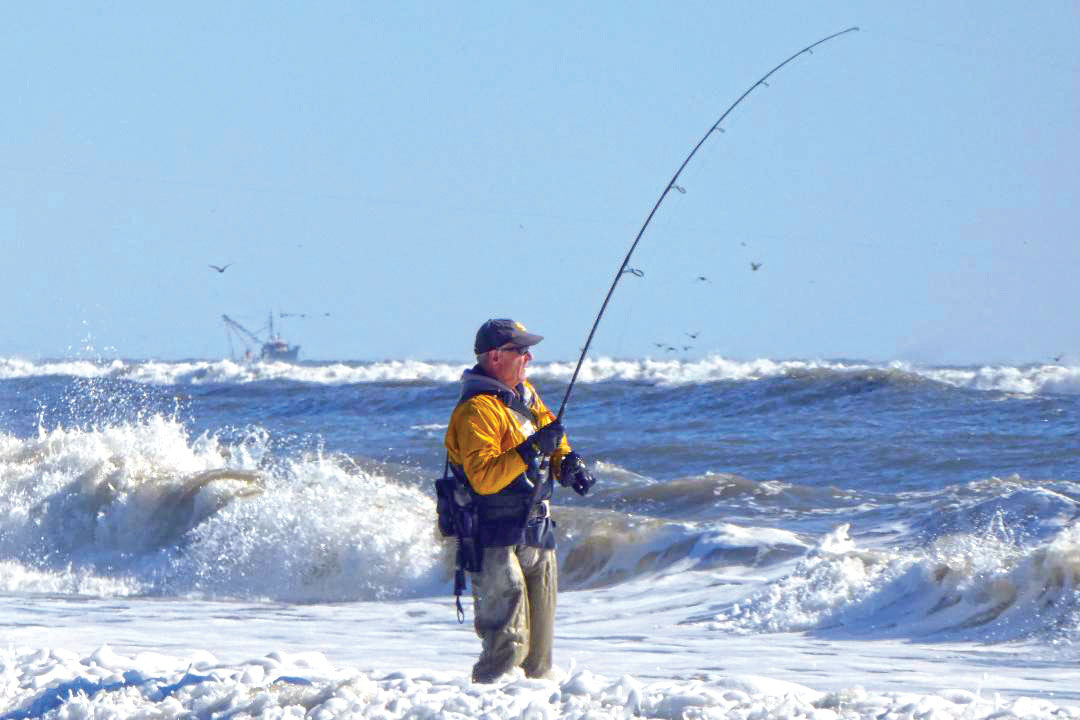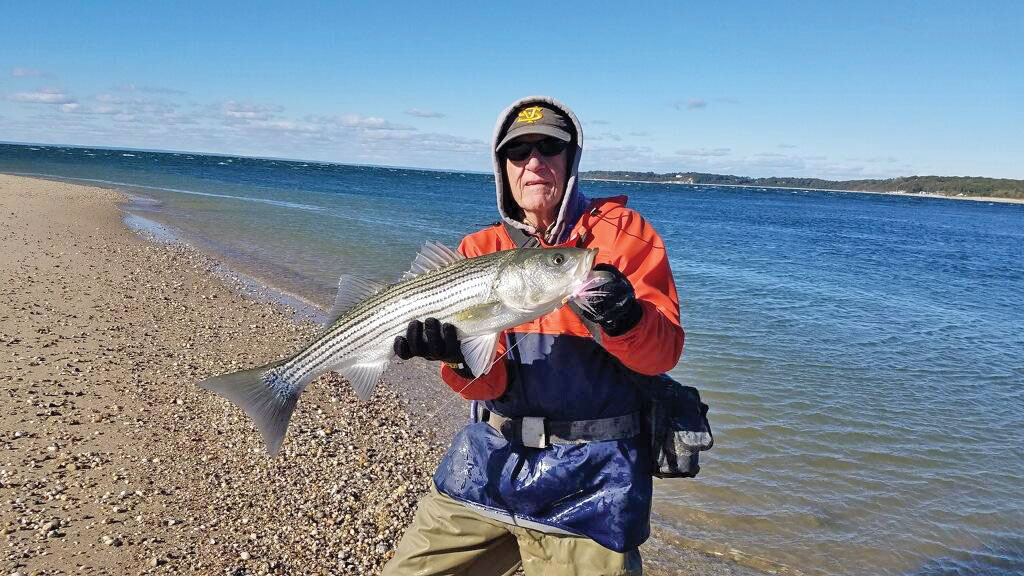
Have your gear ready for the fall season and hope for loads of peanuts early and lots of big sand eels late.
One of the most frustrating yet interesting and exciting aspects of surf fishing is that it changes constantly. For many anglers that may be confusing and annoying, but to others, the challenges of change are relished. For me, the challenges of the sport are as important as catching fish.
Frustrating or not, changes are inevitable. Among the more important things that change are bait; species and abundance, weather patterns, beach structure, and gamefish population sizes. Sorry, but even the best algorithms cannot tell us how bait and fish populations will change, nor can tarot cards and oracles predict weather patterns with any accuracy. My point is that changes will come and no one knows how things will change, or when they’ll arrive.
South Shore
In the last two decades we have witnessed sharp declines in bluefish, striped bass, and weakfish are virtually non-existent. Unfortunately, managers were unable to sustain the strong striped bass stock levels of the 1990s. Declines in stock sizes have profound implications for our fisheries, and not just because we catch fewer fish. Consider the south shore fall run: A highly anticipated yearly event.
In the 1990s, when there were many more large schools of stripers and blues, action usually began in September or early October, as bait and gamefish began to push south. Many anglers believed incorrectly that the fish they caught on any given day were from the same schools that remained in the area until season’s end. Actually, when stocks are large, some schools are pressured to migrate early and push bait as they move, while other schools remain north on cold-adapted baits that resist early migration such as herring, pilchards, smelt, and tinker mackerel. As a result, in the 1990s, bait and gamefish schools dribbled by us in a steady stream, and fishing was consistent. In the last few years, smaller stocks and inconsistent bait spawns have resulted in the movement of one “mega” school of stripers from east to west. Although entertaining when the school passes, the run is short and sweet. Typically, the mega school has arrived along western beaches in November. In addition, bluefish schools have been so uncommon in the fall surf lately that few anglers encounter them. I know I haven’t caught a large blue in the fall surf since 2012.
Mullet Run
Bait changes are important, too. Older surf rats can remember a time in decades past when September to early October mullet runs occurred almost every year. Lately, mullet schools have been so small and so few and far between that there really hasn’t been a mullet run.
Other baits such as bunker spawn inconsistently because success is so dependent upon warm water and higher salinity. We all know that recent spring weather has been both cold and wet: not good for bunker spawning success. In addition, most schools of adult bunker have remained in 60 feet of water due to an absence of blues to chase them from deep water toward the beaches. As a result, large sand eels have been the major bait factor influencing the fall run. And, if sand eels don’t show?
Beach Structure
Then there’s the business of beach structure. Recent falls have witnessed an almost continuous string of nor’easters. They have been frequent and also lasted two or more days compared to decades past when eight to 12 hours was the normal duration. Short nor’easters have much less of an effect on beach structure compared to storms that rage for days.
It once was true that prevailing southwest winds during the summer created great beach structure along the south shore, and with shorter less frequent coastal storms, good structure often held up for much of the fall. The last year I remember good structure holding up through November was during the 2013 great run of mixed size stripers that followed huge numbers of large sand eels onto the beach. However, even in 2013, finding beaches with good structure was hit or miss. For example, at Robert Moses the beach was flat, while some beaches to the east and west enjoyed persistent structure.
North Shore
Sorry, but the North Shore picture hasn’t been any more reliable or impressive, even though structure is much more durable. First, since the Sound contains less water and is shallow compared to the ocean, it heats and cools faster than the south shore ocean. Therefore, most north shore action is finished by early November (except the Nork Fork) because bait has migrated to deeper water and then east, with some stripers; especially Chesapeake fish, following them. In addition, north shore fall action has been dependent upon peanut bunker. More about that later.
Because North Fork beaches poke into the Atlantic a bit, some bait moving south from New England gets funneled west along those beaches. So, in some years the Nork Fork experiences runs of stripers and blues feeding on anchovies, bunker, herring, squid, and peanuts. Sadly, although the Nork Fork often enjoys anchovy runs, the western Sound does not.
However, that said, western Sound beaches usually get a late run of small stripers feeding on pilchards, spearing, and small sand eels. These are Hudson River stock stripers that will winter over in the deep water of the Sound and not migrate. Dedicated north shore salts dread the day when 12- to 16-inch stripers make up the catch because it signals the end of the fishing season up north.

Key Player
Bunker are the key to the surf fishing success on both shores. Here, I’m less interested in the adults than I am in the potential to spawn enormous schools of young (peanuts). However, although bunker year classes in L.I. waters have been fair to good in recent years, none have been great. Then too, because of cold springs, bunker haven’t had successful early spawns even though they are capable of it from April into the summer. Late spawning not only means fewer peanuts but smaller ones, too.
Consider this past spring for example. Let’s have Mr. Peabody (Rocky and Bullwinkle) turn on the “Way-Back” machine and you’ll recall that we experienced winter through much of April and into early May. In a five-day period in early May the water temperature in some spots dropped from around 50 degrees to 42 degrees. Hard to believe now as I swelter in 95-degree heat and Florida humidity, but the spring was cold, wet and windy. That means the early potential spawns of bunker weren’t very successful. You’ll also recall that it rained a lot: low salinity is not conducive to successful spawning. However, it did warm up in late May, has been above average since, with only sporadic local rain, and thus there are now huge schools of teeny peanuts being reported from both shores. Great news except, late summer peanuts will attract less attention because they are small (1-2 inches). With a good early spawn, peanuts would be 4 and 5 inches, and 5 to 6 inches by November. By October this year’s spawn should be 3 to 4 inches, and we can hope that will contribute to the bait pool.
Let’s take a moment to review. The best part of the fall surf season has been late in recent years because of weather, bait, low striper stocks, far fewer big blues, and rapidly changing beach structure. Also, recent early autumns have been mild, and that tends to delay the migration. In addition, bait reproduction has been inconsistent and less bait affects the migration; especially without early fall mullet. As noted, smaller striper stocks have changed migration patterns. Instead of many big schools of stripers in migration, there has been one mega school that arrives late and, once past us, the season is over. Finally, good beach structure holds bait and bait holds gamefish. Contrastingly, flat beaches tend to usher the bait to the west and south.
Approach
Although I’m suggesting that an angler target south shore beaches in November, a smart beach rat keeps his or her ear to the ground for signals that this year’s migration will be different. The best surf anglers have the ability to adapt and adjust to the realities of each season. Suppose, for instance and by some miracle, there is a large amount of mullet this fall. Anyone who waits for November would miss good early fishing.
I have always used a “poke around” approach when fishing is poor. When conditions are potentially good: moon phase, weather, and my ambition come together, I load my gear and roam from beach to beach “poking around” and learning what I can. I can’t say this approach has produced consistent and large catches of fish but, from time to time, I’ve been surprised. More importantly, I gain insight into answers to questions: what is the most abundant bait, how big is it, where did I find the greatest concentrations, and where’s the best structure? I stay in touch with elements of my sport, and then, when a run gets going, I have a much better idea of where to fish and what to use.
The Gear
All that appears above brings us to this juncture. Once a run of fish begins, I want to give myself the best chance of enjoying good catches. Armed with information about structure and patterns, I can select the tackle and lures I believe will be most productive. So, if peanut bunker spawns are abundant, I’ll carry several 2-3/8-ounce Super Strike Little Neck poppers and several Gibbs pencil poppers. On the other hand, if, like 2013 when sand eels dominated, poppers become less important while bucktails and tins with tubes become more important. Although I caught fewer fish, especially big fish, in 2018 compared to November 2013, sand eels dominated, and the best imitators were sub-surface lures.
Unlike many surf anglers, I rarely use teasers. For one thing they tend to tangle as well as reduce casting distance. For another, when blues are around there is a good chance of losing everything to the teeth of a bluefish. Finally, when I do use a teaser, I secure it to a loop created when I tie a leader with a “no name” knot that is not found in any book on knots. The leader and loop are one-piece, and the knot is 100 percent strong. A teaser attached via a dropper loop, on the other hand, is less than 50 percent strong, and even two medium sized stripers; one on the lure and one on the teaser, can break the dropper loop.
Yes, November has been the best fall month in recent years, yet the unexpected is always around the corner. As the old line says, “one never knows, do one.” Stay flexible, remain informed, and have your gear ready for this fall season that I hope is blessed with oodles of peanuts early, and lots of big sand eels late.




